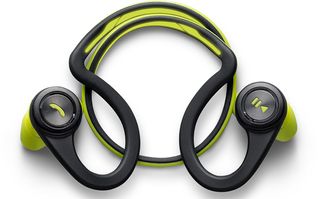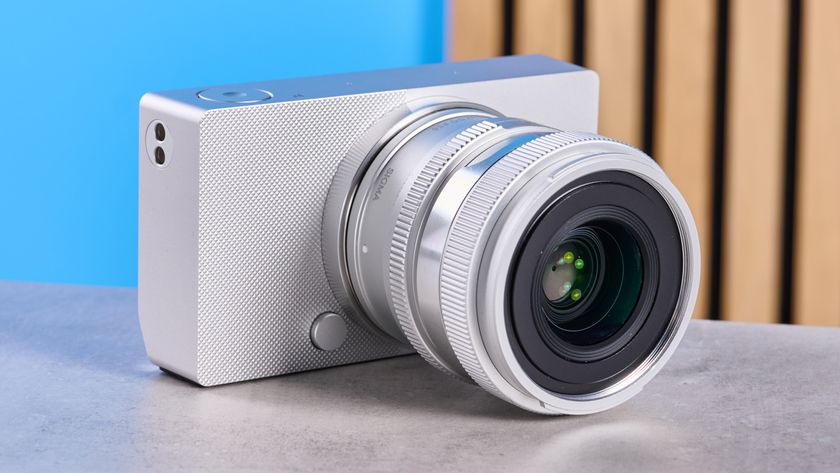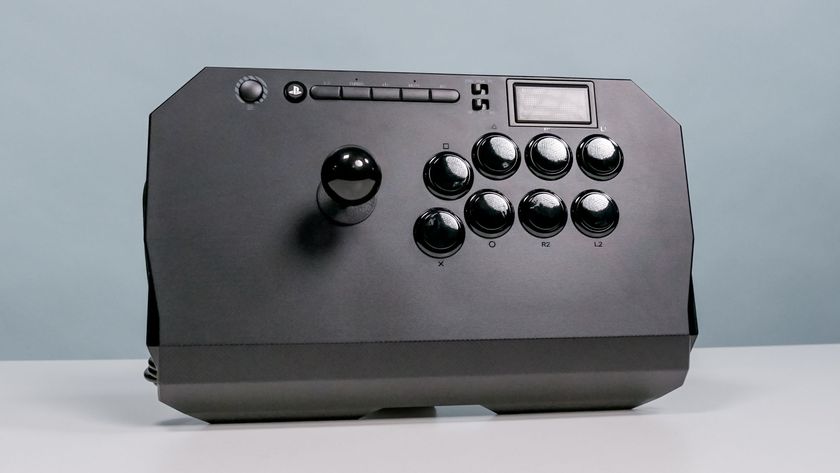Tom's Guide Verdict
The Plantronics BackBeat Fit over-the-ear headphones have solid sound, and touchy but useful controls.
Pros
- +
Strong construction
- +
Nice sound quality
- +
Excellent battery life
- +
Included armband
Cons
- -
May not fit some ears without adjustment
- -
Overly sensitive touch controls/buttons
Why you can trust Tom's Guide
Anyone who listens to music while working out knows that headphone cords inevitably get caught on something, and in-line controls need to be easy to reach. The Plantronics BackBeat Fit aims to solve both of those issues by using Bluetooth to connect to your phone, and putting the controls right on your ears. Plus, these $129 headphones offer very good sound quality, and they come with an armband for carrying your keys or phone when you go to the gym.
Design

The BackBeat Fit earphones are built from softly molded, rubberlike plastic, and loop over the top of your ear. The buds are connected by a flat, plastic band that loops behind your neck. My review unit was turquoise blue, but a neon-green version is available as well. Although the plastic band that fits over your ears and around your head looks heavy, I found the 0.74-ounce headphones quite light.
Large, flat buttons on the outside of the left and right earpieces include Power; Audio (Play/Pause, Skip to next track, Play previous track); and Volume Up and Call (voice commands). While the earphones are powered off, Bluetooth pairing can be set by holding down the Audio button until its bezel flashes red/blue.
MORE: Best Headphones
Included with the Plantronics BackBeat Fit are a standard micro USB charging cable and a reversible armband. The armband pouch can hold the earphones or a device, such as a smartphone. The pouch was large enough for an iPhone + OtterBox or Samsung S3 with Incipio protector, but would be too small for a phablet.
Comfort and Operation

Fitting the BackBeat Fit earphones over several different pairs of ears was tricky. Only one wearer whose ears weren't close to the head had no difficulty. Still, I wore the BackBeat headphones for a couple of successive hours without discomfort.
The BackBeat Fit earpieces have a 40-degree axial range, so a wide range of ear canals have a good chance of a nice fit. After testing them out on several individuals, I found that while they remained secure even while the people were bouncing on a treadmill, the earphones didn't create a very tight seal, so they allowed ambient noise to penetrate. Still, the seal was strong enough that listeners heard music well except in really noisy environments.
The controls are easy to use — almost too easy. While I was fitting the right earpiece, I accidently set the earphones to Mute. Controlling volume was problematic, too. To increase the volume, you tap the Volume button, but to turn it down, you have to press and hold the same button. This means the volume goes up slightly before it goes back down again. I found it easier to hit Mute, and then increase the volume from there.
I also noticed that I could pair the BackBeat earphones with more than one device at a time, but that resulted in a cacophony when both sources were playing.
The carrying case is designed to be turned inside out. It's not tough to reverse the case, but I wondered if it could last through several hundred flips. Its stiffness — though very protective and lending an assured feel — made me feel uneasy about whether it would last a long time. Nonetheless, it's a nice feature and accommodated phones easily.
Audio Performance
I liked the evenness of tonal quality from the BackBeat Fits. The very high highs weren't as defined as other wireless earphones such as the Beats PowerBeats 2, but I didn't miss them except in classical-music sets, where nuance is important. Lows and midrange were smooth, although not as bright or vivid as I would have liked.
MORE: Best Soundbars
Rock, pop and R&B sounded especially good. Tracks from Nirvana sounded detached, but Green Day sounded great. Joe Satriani begged for just a little more upper midrange, but it was still good. Marvin Gaye sounded fantastic. DJ music wasn't quite as vivid, but had a pleasant amount of dynamic range. Jazz, especially traditional NYC jazz like Charles Mingus, was smooth and calming. The range seemed strong, except for the aforementioned very high highs.
Because the BackBeat Fit headphones use the Bluetooth 3.0 spec, they had a range of more than 150 feet from my Bluetooth sources, which included a MacBook Air, an iPhone 5c, a Samsung S3 and a Kenwood Marine "car" stereo.
Call Quality
Call quality on the BackBeat Fit was excellent. I expected nothing less from Plantronics, which has been in the Bluetooth game from the beginning. Conversational sound quality was very good, although the lack of a tight ear seal meant louder ambient noise had me squeezing the earpieces into my ears.
The Call Button doubles as a Decline Call button when held, and you can use voice commands (if your phone supports them) by holding down the Call Button until you hear your phone's voice command tone.
Battery Life
After 12 charge cycles, I determined that the BackBeat Fit's battery can last — given medium volume playback — 8 hours, with the peak at 8:30 and the worst case at 7:21. Raising the volume to the highest tolerated level shortened the life, but not by much; the high was 7:44, and the shortest battery life was 6:09. Charging takes place via a very short micro USB cable.
Bottom Line

Active people can now be liberated from those pesky cables. The $129 Plantronics BackBeat Fit provides excellent sound quality and long battery life for wireless earphones. The sometimes-iffy fit and touchy controls are outweighed by the portability and the included armband. As a Bluetooth device for those working out, the BackBeat Fit headphones are a solid choice.
Follow us @tomsguide, on Facebook and on Google+.
Tom's Guide upgrades your life by helping you decide what products to buy, finding the best deals and showing you how to get the most out of them and solving problems as they arise. Tom's Guide is here to help you accomplish your goals, find great products without the hassle, get the best deals, discover things others don’t want you to know and save time when problems arise. Visit the About Tom's Guide page for more information and to find out how we test products.
-
razor512 How do you change the batteries? batteries do not last forever, and will pretty much always fail long before the rest of the device fails (provided you do not just outright break it)Reply
-
Harry Flashman Does anyone know if these are suitable for listening to audiobooks? My main concern is they might not be loud enough over the noise in the gym.Reply














